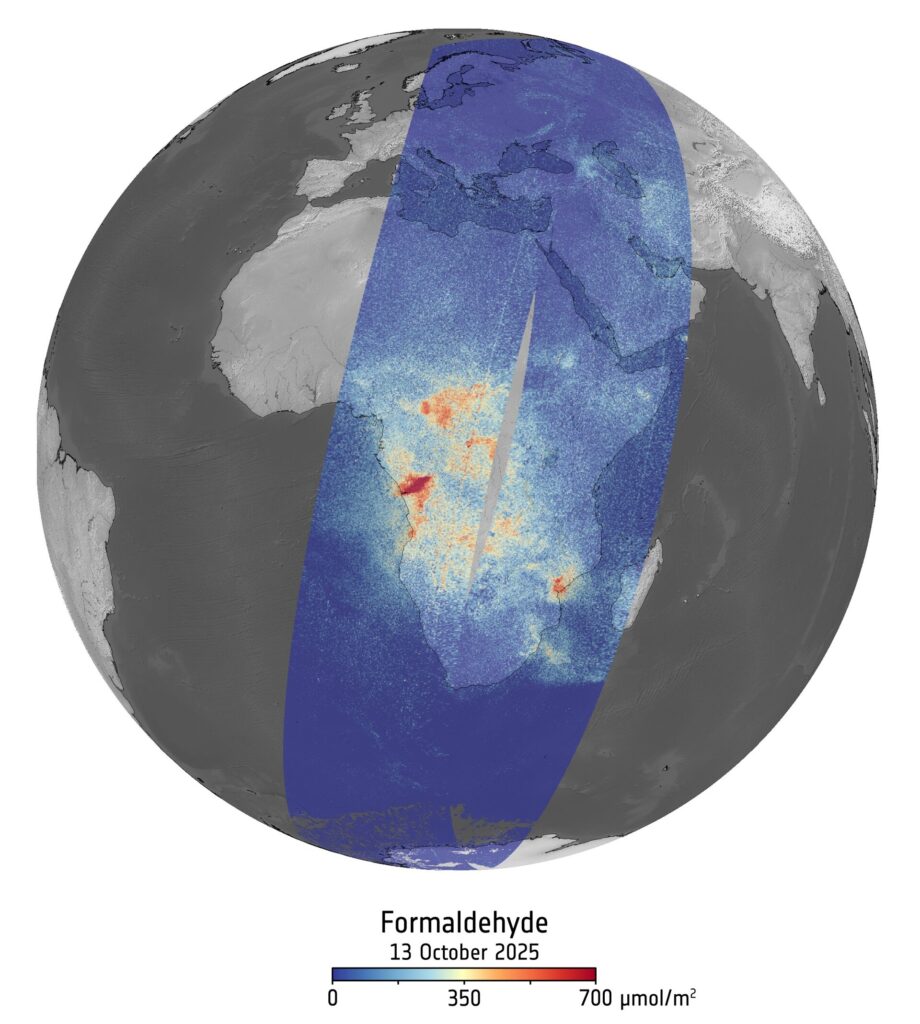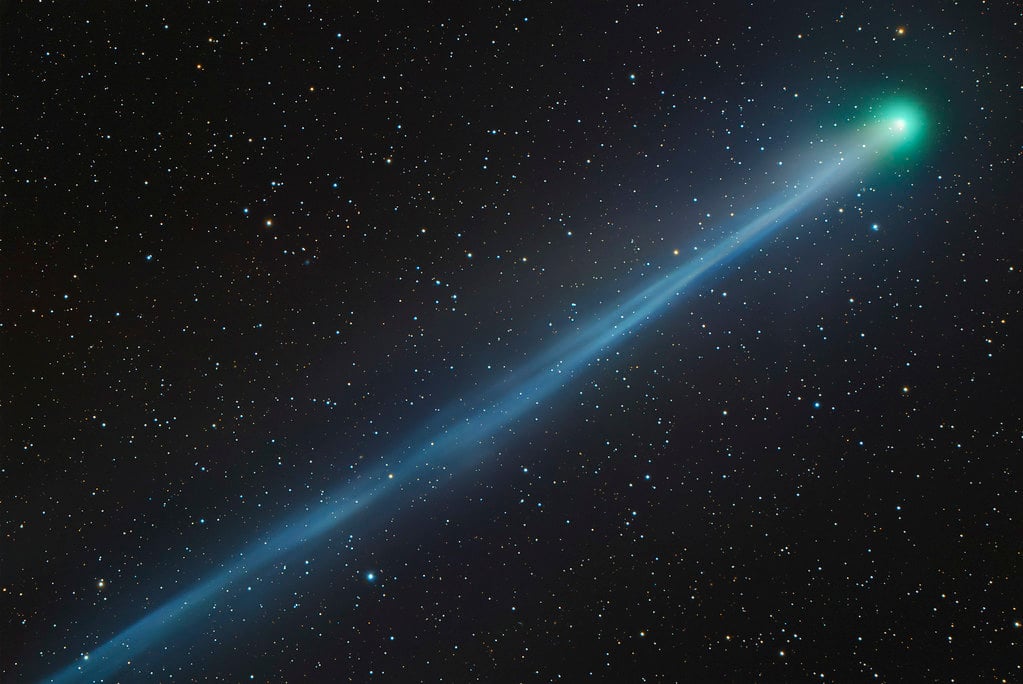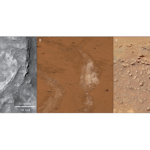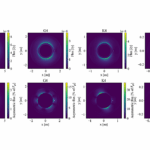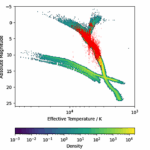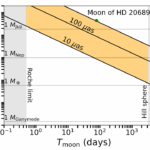Now Reading: ESA’s ExoMars and Mars Express observe comet 3I/ATLAS
-
01
ESA’s ExoMars and Mars Express observe comet 3I/ATLAS
ESA’s ExoMars and Mars Express observe comet 3I/ATLAS
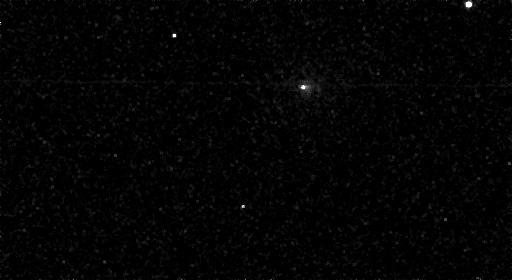

07/10/2025
18648 views
48 likes
The two Mars orbiters had the closest view of the comet of all ESA spacecraft. During its closest approach to the Red Planet on 3 October, the interstellar interloper was 30 million km away from them.
Each spacecraft used its dedicated camera to watch the comet pass. Both cameras are designed to photograph the bright surface of Mars just a few hundred to a few thousand km below. Scientists were unsure what to expect from observations of a relatively dim target so far away.
ExoMars TGO captured the series of images shown in the GIF below with its Colour and Stereo Surface Imaging System (CaSSIS). Comet 3I/ATLAS is the slightly fuzzy white dot moving downwards near the centre of the image. This dot is the centre of the comet, comprising its icy-rocky nucleus and its surrounding coma.
CaSSIS could not distinguish the nucleus from the coma, because 3I/ATLAS was too far away. Imaging this kilometre-wide nucleus would have been as impossible as seeing a mobile phone on the Moon from Earth.
But the coma, measuring a few thousand kilometres across, is clearly visible. The coma is created as 3I/ATLAS approaches the Sun. The Sun’s heat and radiation is bringing the comet to life, causing it to release gas and dust, which collects as this halo surrounding the nucleus.
The full size of the coma could not be measured by CaSSIS because the brightness of the dust decreases quickly with distance from the nucleus. This means that the coma fades into the noise in the image.
Typically, material from the coma is swept into a long tail, which can grow up to millions of kilometres long as the comet moves closer to the Sun. The tail is much dimmer than the coma. We can’t see the tail in the CaSSIS images, but it may become more visible in future observations as the comet continues to heat up and release more ice.
Nick Thomas, Principal Investigator of the CaSSIS camera explains, “This was a very challenging observation for the instrument. The comet is around 10 000 to 100 000 times fainter than our usual target.”
The work continues
3I/ATLAS has not yet revealed itself in the Mars Express images, partly because these were taken with an exposure time of just 0.5 seconds (the maximum limit for Mars Express) compared to five seconds for ExoMars TGO.
Scientists will continue to analyse the data from both orbiters, including adding together several images from Mars Express to see if they can spot the faint comet.
They also tried to measure the spectrum of light from comet 3I/ATLAS using Mars Express’s OMEGA and SPICAM spectrometers, and ExoMars TGO’s NOMAD spectrometer. At this point, it is uncertain whether the coma and tail were bright enough for a spectral characterisation.
Scientists will keep analysing the data over the next weeks and months to try to figure out more about what 3I/ATLAS is made of and how it is behaving as it approaches the Sun.
Colin Wilson, Mars Express and ExoMars project scientist at ESA says: “Though our Mars orbiters continue to make impressive contributions to Mars science, it’s always extra exciting to see them responding to unexpected situations like this one. I look forward to seeing what the data reveals following further analysis.”
A rare visitor
Originating from outside our Solar System, comet 3I/ATLAS is only the third interstellar comet ever seen, following 1I/ʻOumuamua in 2017 and 2I/Borisov in 2019.
These comets are absolutely foreign. Every planet, moon, asteroid, comet and lifeform in our Solar System share a common origin. But interstellar comets are true outsiders, carrying clues about the formation of worlds far beyond our own.
Comet 3I/ATLAS was first spotted on 1 July 2025 by the Asteroid Terrestrial-impact Last Alert System (ATLAS) telescope in Río Hurtado, Chile. Since then, astronomers have used ground-based and space telescopes to monitor its progress and discover more about it.
Based on its trajectory, astronomers suspect that 3I/ATLAS could be the oldest comet ever observed. It may be three billion years older than the Solar System, which is itself already 4.6 billion years old.
What’s next?
Next month, we will observe the comet with our Jupiter Icy Moons Explorer (Juice). Though Juice will be further from 3I/ATLAS than our Mars orbiters were last week, it will see the comet just after its closest approach to the Sun, meaning that it will be in a more active state. We don’t expect to receive data from Juice’s observations until February 2026 – find out why in our FAQs.
Icy wanderers such as 3I/ATLAS offer a rare, tangible connection to the broader galaxy. To actually visit one would connect humankind with the Universe on a far greater scale. To this end, ESA is preparing the Comet Interceptor mission.
Comet Interceptor is due to launch in 2029 into a parking orbit, from where it will lie in wait for a suitable target – a pristine comet from the distant Oort Cloud that surrounds our Solar System, or, unlikely but highly appealing, an interstellar object like 3I/ATLAS.
Michael Kueppers, Comet Interceptor project scientist expands: “When Comet Interceptor was selected in 2019, we only knew of one interstellar object – 1I/ʻOumuamua, discovered in 2017. Since then, two more such objects have been discovered, showing large diversity in their appearance. Visiting one could provide a breakthrough in understanding their nature.”
While it remains improbable that we will discover an interstellar object that is reachable for Comet Interceptor, as a first demonstration of a rapid response mission that waits in space for its target, it will be a pathfinder for possible future missions to intercept these mysterious visitors.
Stay Informed With the Latest & Most Important News
Previous Post
Next Post
-
 012024 in Review: Highlights from NASA in Silicon Valley
012024 in Review: Highlights from NASA in Silicon Valley -
 02Panasonic Leica Summilux DG 15mm f/1.7 ASPH review
02Panasonic Leica Summilux DG 15mm f/1.7 ASPH review -
 03How New NASA, India Earth Satellite NISAR Will See Earth
03How New NASA, India Earth Satellite NISAR Will See Earth -
 04And Thus Begins A New Year For Life On Earth
04And Thus Begins A New Year For Life On Earth -
 05Astronomy Activation Ambassadors: A New Era
05Astronomy Activation Ambassadors: A New Era -
06SpaceX launch surge helps set new global launch record in 2024
-
 07Space Force plans new ‘Futures Command’ amid pressure to speed up modernization
07Space Force plans new ‘Futures Command’ amid pressure to speed up modernization














